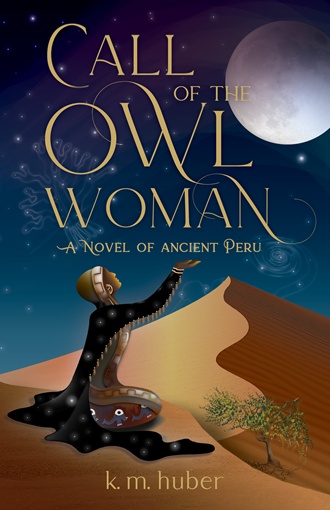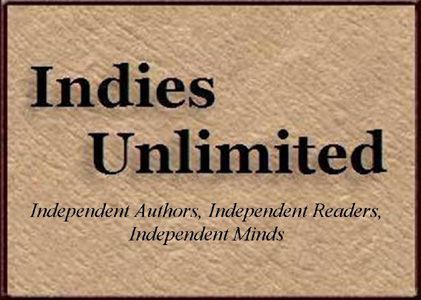Since few people outside of Peru seem to have heard about the many cultures that thrived long before the Incas and the famed Machu Picchu, I wanted to bring one of them to life. I chose the Nasca culture because it faced environmental issues that are relevant to today’s world and is also full of enigmas and mystery.
K.M. Huber – 20 May 2025
The Back Flap
In sixth-century Peru, the Nasca people have flourished for centuries, their faith and ingenuity keeping the desert valleys green in a land where water is scarce. But a prolonged drought now fuels dangerous unrest. Cunning sorcerers and brutal priests vie for control, and Water Guardians like Patya’s father, who refuse to favor the powerful, are under attack.
Devastated by her grandmother’s sudden death, fifteen-year-old Patya retreats into dance and music. She does not want to become a healer like the long lineage of women in her family before her. Even her grandmother had hinted she was born for something else. But, in the wake of a deadly earthquake, Patya must not only help the healers, she must do things she never thought possible. As she begins to conquer her self-doubts and trust her own sense of justice, she will also have to outwit men of power to keep her little brother from being sacrificed by religious extremists at the coming solstice.
As Patya begins to realize and grow into her own power, she also discovers her grandmother’s secret legacy and prepares to step into an unexpected destiny.
About the book
What is the book about?
Call of the Owl Woman – A Novel of Ancient Peru: As her world collapses around her, 15-year-old Patya wrestles with what is expected of her versus what inspires her. When a powerful, corrupt priest threatens Patya’s family, she dares to challenge his interpretation of “the will of the gods” and must navigate the repercussions while trying to save her little brother’s life. Set in the sixth century during a severe drought, Patya’s story is rooted in historical evidence of the mystery-laden period just before Peru’s earth-honoring Nasca culture disappears after successfully thriving in the desert for almost a thousand years.
When did you start writing the book?
The seed was planted twenty years ago in a conversation with my then 13-year-old daughter about what kind of book she would like me to write.
How long did it take you to write it?
The writing started in earnest probably in 2008, but between continued research, life’s detours, travels and moves, I worked on the book off and on for almost 15 years.
Where did you get the idea from?
Since few people outside of Peru seem to have heard about the many cultures that thrived long before the Incas and the famed Machu Picchu, I wanted to bring one of them to life. I chose the Nasca culture because it faced environmental issues that are relevant to today’s world and is also full of enigmas and mystery. One of the enduring questions that surround it has to do with why it collapsed and disappeared after managing to survive in the desert valleys for almost a thousand years.
Were there any parts of the book where you struggled?
It was challenging to find a way to handle the protagonist’s trauma and healing in a way that would not be triggering for those who have experienced similar traumas.
What came easily?
The affectionate relationship between Patya and her little brother.
Are your characters entirely fictitious or have you borrowed from real world people you know?
None of them were specifically based on anyone in particular. When I do notice similarities with someone I know, I am more likely to think that they remind me of my character, not that my character reminds me of them. That said, I must admit that I have been noticing some parallels between my villains and some public figures who act in similar ways.
We all know how important it is for writers to read. Are there any particular authors that have influenced how you write and, if so, how have they influenced you?
When I think back to the books I read when I was a kid, I realize how much Madeline L’Engle’s books opened up a whole new world for me of nerdy heroines and imperfect families and the possibilities of scientific marvels. As I grew up, I loved how Mary Renault could take me into the past and bring to life ancient cultures. I appreciated how Marion Zimmer Bradley brought the mystical, spiritual and sensual elements into her books. I devoured the writings of Anais Nin and Doris Lessing for their observation and introspection. I wished my words could come to life as playfully as Tom Robbins, as poetically as Toni Morrison, as thoughtfully as Alice Walker. Terry Tempest Williams, Eva Saulitis, Robin Wall Kimmerer bring nature to life and into the heart. Octavia Butler’s books are thought-provoking and Nnedi Okorafor takes me places I never imagined going. I could go on and on, but I had better stop here!
Do you have a target reader?
People who love myth, folklore, and the supernatural, as well as adventurers eager to discover new places, people, and ideas in the pages of a book. I would love to reach readers who want to understand themselves and others more deeply, especially those who are curious and willing to challenge their own assumptions.
About Writing
Do you have a writing process? If so can you please describe it?
In general, I tend a bit toward chaos in my process, but I do try to start my day writing down my dreams, hanging out in that liminal space after waking, making notes to remind myself of ideas or record reflections about what I’m working on. I’m more of a panster in the early phase of a project, but like to outline once I have a better sense of where I’m going. I also leave room for my characters to go off in unexpected directions even if it unravels my plans.
Do you outline? If so, do you do so extensively or just chapter headings and a couple of sentences?
My outlines tend to be loose and malleable.
Do you edit as you go or wait until you’ve finished?
Both. Whenever I read over what I’ve written, I always find something I want to tweak, so it’s a challenge to keep myself from diving too deep into those weeds until after I look at the finished project. Sometimes a section that I labored over many times to get just right, ends up not being needed in the greater scheme of things and needs to be let go.
Did you hire a professional editor?
Yes, I did make use of a professional editor.
Do you listen to music while you write? If yes, what gets the fingers tapping?
For some projects, I listen to music relevant to the characters, but when I am in revision mode, my favorite music is stuff designed for focus and ADHD minds.
About Publishing
Did you submit your work to Agents?
I spend a long time in the query trenches, with many nibbles but no contracts
What made you decide to go Indie, whether self-publishing or with an indie publisher? Was it a particular event or a gradual process?
You could say it was a gradual process. Once I felt my work was polished enough, I began researching and exploring traditional options. Ultimately, I came to the conclusion that my project was not an easy fit for the traditional market route and that time was passing all too quickly. My writing had always taken a back seat to other work and family commitments, but now, at 70, it is front and center. My other projects are also impatient to get going, so I don’t want to waste time. I heard good things about the quality of the hybrid publishing sister presses She Writes and SparkPress, so I submitted my book, got the green light, and have been going full speed ahead ever since.
Did you get your book cover professionally done or did you do it yourself?
My publisher has a great cover design department, but I also sent them my daughter’s artwork to consider. They liked it enough to incorporate her art, and designed a beautiful cover with a wonderfully coordinated interior design.
Do you have a marketing plan for the book or are you just winging it?
In addition to the marketing and distribution that the publisher does, I hired a publicist to help the book reach its audience. Like many authors, I’m not good with the sales and marketing elements. I am working on developing those skills but would rather be writing!
Any advice that you would like to give to other newbies considering becoming Indie authors?
Do your research. Read articles, attend webinars, and find your community. I recommend joining Authors Guild and using their legal services to go over contracts before signing anything, and talk to other authors who have used the publishers you are considering.
About You
Where did you grow up?
Just north of Seattle, Washington.
Where do you live now?
Maryville, TN.
What would you like readers to know about you?
I believe that books can work magic. They can not only entertain us, but also offer refuge when we’re hurting, healing when we need it, challenges when we are ready, and bridges to understanding across time and place and deep divides. I also believe the same thing about the being in, and connecting with, nature and the non-human world.
What are you working on now?
I am juggling several projects: 1) a sequel to Call of the Owl Woman; 2) a middle-grade historical fantasy in 1920s New York City where two 11-year-olds discover the ability to transport themselves instantly to other places around the world; and 3) a ”speculative biography” with a soul-searching San Francisco artist whose serendipitous involvement with Gertrude Stein and the modernists launches her into lifetime of psychological exploration from Freud and Jung to Gurdjieff—and all the way into the 1960’s psychedelics scene in San Francisco.
Then I want to resurrect the first novel I ever wrote—a dual timeline bridging WWI and the Vietnam conflict that follows the newly widowed Maggie when her granddaughter challenges her to re-discover and reclaim the self that she abandoned when her adored older brother, an active pacifist, suddenly goes to fight and die in France with no goodbye or explanation. When I queried the book 30 years ago, most agents insisted that there was no audience for a novel set in a retirement home. Now that the demographics have changed, it might have a better chance!
End of Interview:
For more from K.M. Humber visit her website.
Get your copy of Call of the Owl Woman from Amazon US.


